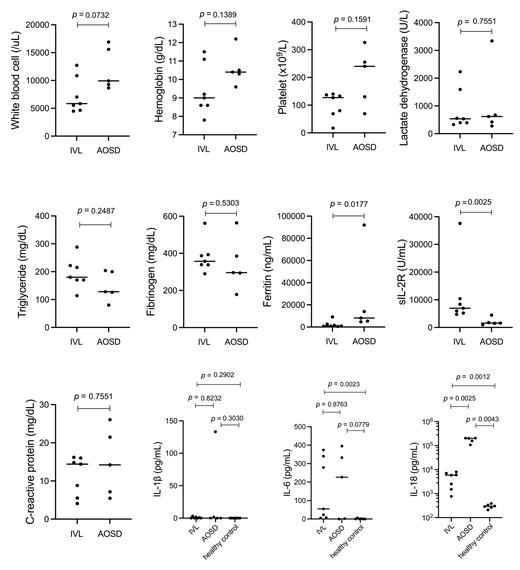Intravascular lymphoma (IVL) is an extremely rare and aggressive form of non-Hodgkin's lymphoma characterized by lymphoma cells localized within blood vessels. Due to its rapid progression and life-threatening nature, prompt diagnosis and swift treatment are essential. However, IVL often presents with nonspecific systemic symptoms such as fever, fatigue, weight loss, skin rash, and neurological impairment without noticeable lymph node enlargement. As a result, diagnosing IVL is highly challenging, and it is frequently misdiagnosed as other conditions. A definitive diagnosis of IVL requires tissue biopsy, like a random skin biopsy, although this may not always lead to the identification of IVL from the biopsy site. Consequently, when IVL is suspected, repeated random skin biopsies may be necessary, but the optimal number of biopsies remains unknown. To avoid repetitive invasive procedures, clinical indicators that raise suspicion of IVL more aggressively in patients with nonspecific symptoms are needed.
IVL often presents with clinical features that resemble adult-onset Still disease (AOSD), particularly with systemic symptoms such as fever and hemophagocytic lymphohistiocytosis (HLH). Distinguishing between IVL and AOSD is crucial, but the lack of disease-specific markers for each condition makes differentiation challenging. While recent studies suggest the utility of genetic mutation analysis using cell-free DNA for diagnosing IVL, cost and technical limitations call for the development of simpler diagnostic adjunct markers. Therefore, our study aimed to explore potential useful indicators for differentiating IVL by comparing clinical parameters used for AOSD diagnosis in both IVL and AOSD patients.
We conducted a comparative analysis using clinical data and initial samples from seven patients diagnosed histologically with IVL and five AOSD patients who were confirmed negative for IVL through long-term follow-up. Additionally, samples from six healthy donors were included for comparison. The median age of IVL patients was 64 years, while AOSD patients were 47 years old, with no significant difference between the groups (p=0.668). White blood cell count, hemoglobin concentration, platelet count,lactate dehydrogenase (LDH), triglycerides, fibrinogen, and C-reactive protein showed no significant differences between IVL and AOSD patients. On the other hand, ferritin levels were significantly lower in IVL patients compared to AOSD patients (539-9164 vs. 4690-91917 ng/mL, p=0.018), and soluble interleukin-2 receptor (sIL-2R) levels were significantly higher in IVL patients (4714-37572 vs. 935-4441 U/mL, p=0.003). Furthermore, the inflammatory cytokines IL-1β, IL-6, and IL-18 were measured, and while IL-1β and IL-6 showed no significant differences between IVL and AOSD patients, IL-18 was significantly higher in AOSD (0.77x10 3-8.04x10 3 vs. 1.07x10 5-2.05x10 5 pg/mL, p=0.003) (Figure).
The presence of HLH did not impact ferritin, sIL-2R, or IL-18 levels in IVL patients. Additionally, the presence of bone marrow infiltration by IVL cells did not influence the clinical parameters, including ferritin, sIL-2R, and IL-18. Furthermore, ROC analysis was performed to assess the usefulness of ferritin, sIL-2R, and IL-18 in differentiating IVL and AOSD, revealing that less than 10000 pg/mL for IL-18 and above 5000 U/mL for sIL-2R ensured a reliable differentiation between IVL and AOSD.
In conclusion, IL-18 and sIL-2R showed significant differences between IVL and AOSD, suggesting their potential as useful indicators for distinguishing the two conditions. Furthermore, when investigating cases of fever of unknown origin, it is crucial to diligently perform procedures such as random skin biopsies in patients strongly suspected of having IVL based on the values of IL-18 and sIL-2R.
Disclosures
Kato:AbbVie: Consultancy, Research Funding; AstraZeneca: Consultancy; Chugai: Consultancy, Honoraria, Research Funding; Daiichi Sankyo: Consultancy, Research Funding; Eisai: Consultancy, Research Funding; Janssen: Consultancy, Honoraria, Research Funding; Novartis: Consultancy, Honoraria, Research Funding; MSD: Honoraria, Research Funding; Bristol-Myers Squibb: Honoraria, Research Funding; Kyowa Kirin: Honoraria, Research Funding; Ono: Honoraria, Research Funding.


This feature is available to Subscribers Only
Sign In or Create an Account Close Modal